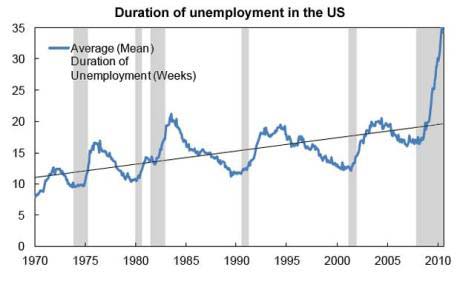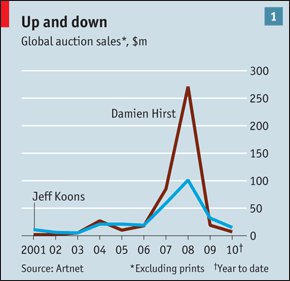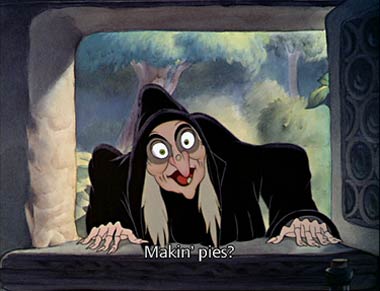uh oh

Like a Middle Eastern version of Las Vegas, Dubai’s biggest challenge is water, which may be everywhere in the gulf but is undrinkable without desalination plants. These produce emissions of carbon dioxide that have helped give Dubai and the other United Arab Emirates one of the world’s largest carbon footprints. They also generate enormous amounts of heated sludge, which is pumped back into the sea.
The emirates desalinate the equivalent of four billion bottles of water a day. But their backups are thin: at any given time, the region has, on average, an estimated four-day supply of fresh water.
{ NY Times | Continue reading }
photo { Nicholas Haggard }
asia, uh oh, water, within the world | October 28th, 2010 8:17 am

Some astronauts report losing their fingernails on spacewalks because of bulky gloves that cut off circulation and chafe against their hands. To avoid this inconvenience, a couple astronauts have taken to ripping off their own fingernails before reaching orbit.
{ PopSci | Continue reading }
Of the nearly 500 planets known beyond our solar system, nearly all appear to be gas-shrouded giants like Jupiter or Neptune, and most are either too hot or too cold to harbor life-giving liquid water. In contrast, with only three to four times the mass of Earth, Gliese 581g is probably mostly made of rock, and is at the proper distance from its star to have lakes, seas, even oceans of water upon its surface. If confirmed by follow-up observations, Gliese 581g will be the most promising potentially habitable planet discovered so far.
{ Seed | Continue reading }
photo { Li Wei }
space, uh oh | October 25th, 2010 12:44 pm

It has always been tough for literary fiction writers to get their work published by the top publishing houses. But the digital revolution that is disrupting the economic model of the book industry is having an outsize impact on the careers of literary writers.
Priced much lower than hardcovers, many e-books generate less income for publishers. And big retailers are buying fewer titles. As a result, the publishers who nurtured generations of America’s top literary-fiction writers are approving fewer book deals and signing fewer new writers. Most of those getting published are receiving smaller advances.
“Advances are down, and there aren’t as many debuts as before,” says Ira Silverberg, a well-known literary agent. “We’re all trying to figure out what the business is as it goes through this digital disruption.”
Much as cheap digital-music downloads have meant that fewer bands can earn a living from record-company deals, fewer literary authors will be able to support themselves as e-books win acceptance, publishers and agents say.
{ Wikipedia | Continue reading }
photo { Tim Geoghegan }
previously { Seth Godin: The new dynamics of book publishing }
books, economics, technology, uh oh | September 29th, 2010 8:13 am
showbiz, uh oh, weirdos | September 22nd, 2010 9:05 am

On May 15, 1985, trainers at Hawaii Sea Life Park were stunned when a 400- pound gray female bottlenose dolphin named Punahele gave birth to a dark-skinned calf that partly resembled the 2,000-pound male false killer whale with whom she shared a pool. The calf was a wholphin, a hybrid that was intermediate to its parents in some characteristics, like having 66 teeth compared with the bottlenose’s 88 and the 44 of the false killer whale, a much larger member of the dolphin family. (…)
While several examples of human-bred animal hybrids are well known and can thrive in captivity including zorses (zebra-horse), beefalo (bison-beef cattle) and, of course, mules (donkey-horse), naturally occurring animal hybrids have many factors working against their longer-term success.
{ NY Times | Continue reading }
animals, science, uh oh | September 18th, 2010 8:40 am

{ America and Europe face the worst jobs crisis since the 1930s and risk “an explosion of social unrest” unless they tread carefully, the International Monetary Fund has warned. | Telegraph | full story }
economics, incidents, uh oh | September 15th, 2010 1:00 am

{ But who exactly bought what? Even Mr Hirst admits, “I’m still finding out.” Dealers acquired some works, but 81% of the buyers were private collectors purchasing directly. | How Damien Hirst grew rich at the expense of his investors | The Economist | full story }

{ The Art Damien Hirst Stole | more | Thanks Tim }
art, economics, haha, jeff koons, scams and heists, uh oh | September 13th, 2010 1:32 am
art, halves-pairs, uh oh, visual design | September 4th, 2010 8:22 am

Natural lightning is caused by the build-up of electric charge in thunderstorms. Florida, lying out as a prong between the Gulf of Mexico and the Atlantic Ocean, is especially prone to these. Sea breezes from the two warm bodies of water head inland and collide over the centre of the state. The warm air rushes upwards and then condenses into rain, ice, hail and something called graupel (a mixture of all three). As those particles collide and rub against each other, positive and negative electrical charges build up and separate in the clouds. Lightning occurs when those charges become so great that the air breaks down and conducts electricity between the two – mostly from cloud to cloud, but also down to the ground. “Triggered” lightning works by firing a rocket into the storm at around this moment. A copper wire attached to the rocket offers the charge an easy route to the ground and, about 70 per cent of the time, it takes it. (…)
The resulting wave of research, much of it funded by Nasa, laid the basis for current lightning safety. Many of lightning’s physical characteristics – its speed, temperature and current – were ascertained. Triggered lightning was used to test aircraft parts, runways, houses and power lines, and detection systems for lightning strikes were built across the world. Lightning still kills about 25,000 people a year (overwhelmingly in the developing world) and causes $1bn of damage annually in the US, but in terms of protection at least, a truce was declared.
In terms of how we understand it, however, lightning has only got stranger. The past 20 years have seen a series of confounding discoveries. In 1989, a group of scientists from the University of Minnesota were testing a video camera when they accidentally recorded an odd blossom of lightning rising out of the top of a storm. Over the next decade, other unexplained luminous phenomena (dubbed “Red Sprites”, “Blue Jets” and “Elves”) were also identified, billowing up from thunderstorms in columns and rings as high as 100km above Earth. Complicating matters further, in 2001 lightning was found to emit radiation. Not in odd or meagre quantities either. At every single stagger and step, lightning channels are now known to generate enough X-rays for a chest X-ray, despite having no obvious physical means to do so. Sometimes they also manage to blast off huge quantities of gamma rays, more often associated with collapsing stars – a process that may pose an as-yet poorly understood risk to aircraft.
{ Financial Times | Continue reading }
image { Pierre Huyghe, No Ghost, Just a Shell, 2001 | More: video }
climate, mystery and paranormal, science, uh oh | August 25th, 2010 12:42 pm

The quality and quantity of individuals’ social relationships has been linked not only to mental health but also to both morbidity and mortality. (…)
Humans are naturally social. Yet, the modern way of life in industrialized countries is greatly reducing the quantity and quality of social relationships. Many people in these countries no longer live in extended families or even near each other. Instead, they often live on the other side of the country or even across the world from their relatives. Many also delay getting married and having children. Likewise, more and more people of all ages in developed countries are living alone, and loneliness is becoming increasingly common.
In the UK, according to a recent survey by the Mental Health Foundation, 10% of people often feel lonely, a third have a close friend or relative who they think is very lonely, and half think that people are getting lonelier in general. Similarly, across the Atlantic, over the past two decades there has been a three-fold increase in the number of Americans who say they have no close confidants. There is reason to believe that people are becoming more socially isolated.
Some experts think that social isolation is bad for human health. They point to a 1988 review of five prospective studies that showed that people with fewer social relationships die earlier on average than those with more social relationships. (…)
The researchers identified 148 prospective studies that provided data on individuals’ mortality as a function of social relationships and extracted an “effect size” from each study. (…)
The findings indicate that the influence of social relationships on the risk of death are comparable with well-established risk factors for mortality such as smoking and alcohol consumption and exceed the influence of other risk factors such as physical inactivity and obesity.
{ Plos Medecine | Continue reading }
photo { Paige de Ponte }
relationships, science, uh oh | August 23rd, 2010 11:42 am

Richard Freiherr von Krafft-Ebing (1840–1902) was an Austro-German sexologist and psychiatrist.
He wrote Psychopathia Sexualis (1886) [book cover], a notable series of case studies of the varieties of human sexual behaviour. The book remains well known for his coinage of the terms sadism (from Marquis de Sade whose fictional writings often include brutal sexual practices) and masochism (from writer Leopold von Sacher-Masoch, whose partly autobiographical novel Venus in Furs tells of the protagonist’s desire to be whipped and enslaved by a beautiful woman). (…)
In the first edition of Psychopathia Sexualis, Krafft-Ebing divided “cerebral neuroses” into four categories:
• paradoxia: Sexual desire at the wrong time of life, i.e. childhood or old age
• anesthesia: Insufficient sexual desire
• hyperesthesia: Excessive sexual desire
• paraesthesia: Sexual desire for the wrong goal or object, including homosexuality (”contrary sexual desire”), sexual fetishism, sadism, masochism, paedophilia , etc.
Krafft-Ebing believed that the purpose of sexual desire was procreation, and that any form of desire that did not go towards that ultimate goal was a perversion. Rape, for instance, was an aberrant act, but not a perversion, because pregnancy could result.
He saw women as sexually passive, and recorded no female sadists or fetishists in his case studies. Behaviour that would be classified as masochism in men was categorized in women as “sexual bondage,” which, because it did not interfere with procreation, was not a perversion.
{ Wikipedia | Continue reading }
books, fetish, psychology, uh oh | August 18th, 2010 12:03 am

“I don’t believe society understands what happens when everything is available, knowable and recorded by everyone all the time,” he says. He predicts, apparently seriously, that every young person one day will be entitled automatically to change his or her name on reaching adulthood in order to disown youthful hijinks stored on their friends’ social media sites.
{ Interview with Eric Schmidt, Google’s CEO | Wall Street Journal | Continue reading }
google, social networks, technology, uh oh | August 16th, 2010 7:50 pm

Mysterious and possibly nefarious trading algorithms are operating every minute of every day in the nation’s stock exchanges.
What they do doesn’t show up in Google Finance, let alone in the pages of the Wall Street Journal. No one really knows how they operate or why. But over the past few weeks, Nanex, a data services firm has dragged some of the odder algorithm specimens into the light.
The trading bots visualized in the stock charts in this story aren’t doing anything that could be construed to help the market. Unknown entities for unknown reasons are sending thousands of orders a second through the electronic stock exchanges with no intent to actually trade. Often, the buy or sell prices that they are offering are so far from the market price that there’s no way they’d ever be part of a trade. The bots sketch out odd patterns with their orders, leaving patterns in the data that are largely invisible to market participants.
{ The Atlantic | Continue reading }
artwork { Jean-Michel Basquiat }
related { Quants: The Alchemists of Wall Street | video | Thanks Douglas }
economics, technology, traders, uh oh | August 9th, 2010 6:58 pm
U.S., spy & security, uh oh | July 21st, 2010 10:28 am

Breaking Up is Hard to Do, Unless Everyone Else is Doing it Too: Social Network Effects on Divorce in a Longitudinal Sample Followed for 32 Years
Divorce is the dissolution of a social tie, but it is also possible that attitudes about divorce flow across social ties. To explore how social networks influence divorce and vice versa, we utilize a longitudinal data set from the long-running Framingham Heart Study. We find that divorce can spread between friends, siblings, and coworkers, and there are clusters of divorcees that extend two degrees of separation in the network. We also find that popular people are less likely to get divorced, divorcees have denser social networks, and they are much more likely to remarry other divorcees. Interestingly, we do not find that the presence of children influences the likelihood of divorce, but we do find that each child reduces the susceptibility to being influenced by peers who get divorced. Overall, the results suggest that attending to the health of one’s friends’ marriages serves to support and enhance the durability of one’s own relationship, and that, from a policy perspective, divorce should be understood as a collective phenomenon that extends far beyond those directly affected.
{ Social Science Research Network | via The Situationist }
photo { Bill Owens }
relationships, social networks, uh oh | June 26th, 2010 7:31 am

Errors in the way physicists estimate the effects of dark matter and dark energy on the leftover heat from the Big Bang has thrown their existence into doubt, say British scientists.
Physicists’ general model of the universe includes two ‘dark’ concepts.
Dark energy is a force that explains the way that galaxies accelerate away from each other, while dark matter was postulated to explain the observations that galaxies have more mass than can be accounted for by stars and gas.
Evidence for the ‘dark side’ comes primarily from studies of the Cosmic Background Radiation (CMB), the leftover ‘glow’ from the Big Bang, which has been analysed in detail by the Wilkinson Microwave Anisotropy Probe (WMAP), a NASA satellite telescope launched in 2001 that provided the first full-sky map of the CMB.
Now, some scientists say errors in the WMAP data may be larger than expected.
This would mean that there is no need to include dark matter and dark energy in models of the cosmos.
{ Cosmos | Continue reading }
science, space, uh oh | June 24th, 2010 7:26 am

Americans are getting increasingly anxious–and for good reason.
People are worried about the economy, and they should be. They have been told to expect a strong rebound from our deep recession. The usual pattern is that recoveries mirror the strength of the decline–the steeper the drop, the more vigorous the rebound. It isn’t happening. The latest employment report makes it clear that the economy is not adding jobs. State and local governments faced with declining revenues are being forced to cut employment, wages and services, and they are raising taxes wherever they can.
A little over a year ago the Obama administration passed a staggering $787 billion stimulus package designed to rescue the economy. More than half of that money has now been spent, and the economy is still just creaking along. But now people are realizing that there is a dark side to this spending orgy. It has to end, and then we have to pay the bill. If we need any reminders that the day of reckoning is coming we have only to look to Europe.
{ Forbes | Continue reading }
For years, almost nobody paid attention to the sky-is-falling alarms of Edward Hugh, a gregarious British blogger and self-taught economist who repeatedly predicted that the euro zone could not survive. (…)
But now that the European sovereign debt crisis is rattling world markets, driving the euro lower almost every day and raising doubts about the future of the monetary union, his voluminous musings have become a must-read for an influential and growing global audience, including policy makers in the White House.
{ CNBC | Continue reading | Thansk Douglas }
related:
Personal Bankruptcies Jump 9% In May, And The Outlook For The Year Has Been Jacked Up.
China bank adviser says property woes worse than US.
Europe’s financial woes will hit the global economy, warns the governor of the Australian central bank, Glenn Stevens.
Public Pensions Could Bankrupt California.
Venice forced to sell off dozens of historic palazzos in order to bolster fast-diminishing funds.
U.S., economics, uh oh, within the world | June 10th, 2010 8:29 am

An earworm is a song going around in your head that you can’t get rid of. Some claim that earworms are like a cognitive itch, we scratch them by repeating the tune over and over in our heads.
In new research, Beaman & Williams (2010) asked 103 participants aged 15-57 all about their earworm experiences. Here’s what they found:
• Many earworms were pop songs, although adverts and TV/film themes and video game tunes were also mentioned.
• One-third generally experienced the chorus or refrain over and over again, but almost half said that it varied.
• 10% of participants reported that earworms stopped them doing other things.
• Contrary to popular belief those with musical training were no more likely to experience earworms. (…)
For most of us earworms are relatively untroubling. And if you are tempted to moan then just be thankful you’re not the 21-year-old described in a case report by Praharaj et al. (2009). This man had had music from Hindi films going around in his head against his will for between 2 and 45 minutes at a time, up to 35 times a day, for five years. Unfortunately even powerful drugs couldn’t stop the music.
{ PsyBlog | Continue reading }
It sometimes feel like our minds are not on the same team as us. I want to go to sleep, but it wants to keep me awake rerunning events from my childhood. I want to forget the lyrics from that stupid 80s pop song but it wants to repeat them over and over again ad nauseam. (…)
Perpetual thoughts of food drive people to obesity, persistent negative thoughts cue depression and traumatic events push back into consciousness to be relived over and over again. (…)
Although it makes perfect intuitive sense to try and suppress unwanted thoughts, unfortunately the very process we use to do this contains the seeds of its own destruction. The more we try and push intrusive thoughts down, the more they pop back up, stronger than ever.
{ PsyBlog | Continue reading }
photos { Kate Moss photographed by Michael Thompson, 1993 }
related { Kate Moss shows off six piercings after visit to tattoo parlour, 2009 }
bonus:

music, psychology, science, uh oh | June 8th, 2010 7:44 pm
animals, uh oh | June 8th, 2010 7:40 pm

The M3 money supply in the United States is contracting at an accelerating rate that now matches the average decline seen from 1929 to 1933, despite near zero interest rates and the biggest fiscal blitz in history.
The M3 figures - which include broad range of bank accounts and are tracked by British and European monetarists for warning signals about the direction of the US economy a year or so in advance - began shrinking last summer. The pace has since quickened. (…)
Mr Congdon said the dominant voices in US policy-making - Nobel laureates Paul Krugman and Joe Stiglitz, as well as Mr Summers and Fed chair Ben Bernanke - are all Keynesians of different stripes who “despise traditional monetary theory and have a religious aversion to any mention of the quantity of money”. The great opus by Milton Friedman and Anna Schwartz - The Monetary History of the United States - has been left to gather dust.
Mr Bernanke no longer pays attention to the M3 data. The bank stopped publishing the data five years ago, deeming it too erratic to be of much use.
This may have been a serious error since double-digit growth of M3 during the US housing bubble gave clear warnings that the boom was out of control. The sudden slowdown in M3 in early to mid-2008 - just as the Fed talked of raising rates - gave a second warning that the economy was about to go into a nosedive.
Mr Bernanke built his academic reputation on the study of the credit mechanism. This model offers a radically different theory for how the financial system works. While so-called “creditism” has become the new orthodoxy in US central banking, it has not yet been tested over time and may yet prove to be a misadventure.
{ The Telegraph | Continue reading }
Europe is in crisis. Austerity measures have been announced in several countries including Greece and Spain, the euro is under pressure and stock markets across the globe have fallen sharply from their recent highs – and it is all due mainly to sovereign debt. (…)
What has caused the debt crisis?
In a word or two, over-borrowing. Sovereign debt is fine so long as the governments have no problem repaying the debt. But several countries have borrowed beyond their means – the ramifications of the financial crisis have left them struggling to repay their debt. This is why the IMF has agreed a financial package to bail them out.
Greece and other countries will struggle to pay off these debts. This has led to a dramatic spike in borrowing costs for these countries, exacerbating the problems further,” Mr Howse added. “Investors have begun to question the future of European Economic and Monetary Union and whether the crisis may spread beyond the peripheral European countries.
{ The Telegraph | Continue reading }
U.S., economics, uh oh, within the world | June 7th, 2010 8:20 pm



























